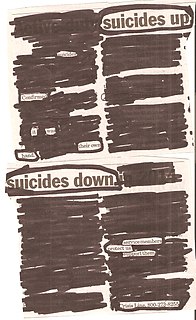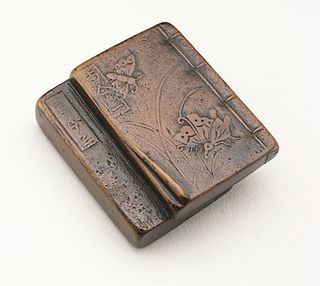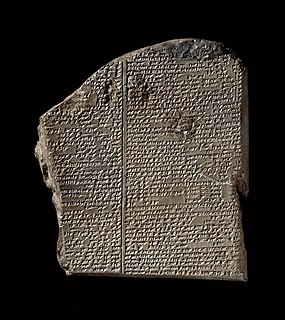Related Research Articles

Haiku is a type of short form poetry originally from Japan. Traditional Japanese haiku consist of three phrases that contain a kireji, or "cutting word", 17 on in a 5, 7, 5 pattern, and a kigo, or seasonal reference. Similar poems that do not adhere to these rules are generally classified as senryū.
In poetry, metre or meter is the basic rhythmic structure of a verse or lines in verse. Many traditional verse forms prescribe a specific verse metre, or a certain set of metres alternating in a particular order. The study and the actual use of metres and forms of versification are both known as prosody.

Poetry is a form of literature that uses aesthetic and often rhythmic qualities of language − such as phonaesthetics, sound symbolism, and metre − to evoke meanings in addition to, or in place of, a prosaic ostensible meaning. A poem is a literary composition, written by a poet, using this principle.
Senryū is a Japanese form of short poetry similar to haiku in construction: three lines with 17 morae. Senryū tend to be about human foibles while haiku tend to be about nature, and senryū are often cynical or darkly humorous while haiku are more serious. Unlike haiku, senryū do not include a kireji, and do not generally include a kigo, or season word.
Constrained writing is a literary technique in which the writer is bound by some condition that forbids certain things or imposes a pattern.

Found poetry is a type of poetry created by taking words, phrases, and sometimes whole passages from other sources and reframing them by making changes in spacing and lines, or by adding or deleting text, thus imparting new meaning. The resulting poem can be defined as either treated: changed in a profound and systematic manner; or untreated: virtually unchanged from the order, syntax and meaning of the poem.
"In a Station of the Metro" is an Imagist poem by Ezra Pound published in April 1913 in the literary magazine Poetry. In the poem, Pound describes a moment in the underground metro station in Paris in 1912; he suggested that the faces of the individuals in the metro were best put into a poem not with a description but with an "equation". Because of the treatment of the subject's appearance by way of the poem's own visuality, it is considered a quintessential Imagist text.
Syllabic verse is a poetic form having a fixed or constrained number of syllables per line, while stress, quantity, or tone play a distinctly secondary role — or no role at all — in the verse structure. It is common in languages that are syllable-timed, such as French or Finnish — as opposed to stress-timed languages such as English, in which accentual verse and accentual-syllabic verse are more common.

Japanese poetry is poetry typical of Japan, or written, spoken, or chanted in the Japanese language, which includes Old Japanese, Early Middle Japanese, Late Middle Japanese, and Modern Japanese, as well as poetry in Japan which was written in the Chinese language or ryūka from the Okinawa Islands: it is possible to make a more accurate distinction between Japanese poetry written in Japan or by Japanese people in other languages versus that written in the Japanese language by speaking of Japanese-language poetry. Much of the literary record of Japanese poetry begins when Japanese poets encountered Chinese poetry during the Tang dynasty. Under the influence of the Chinese poets of this era Japanese began to compose poetry in Chinese kanshi); and, as part of this tradition, poetry in Japan tended to be intimately associated with pictorial painting, partly because of the influence of Chinese arts, and the tradition of the use of ink and brush for both writing and drawing. It took several hundred years to digest the foreign impact and make it an integral part of Japanese culture and to merge this kanshi poetry into a Japanese language literary tradition, and then later to develop the diversity of unique poetic forms of native poetry, such as waka, haikai, and other more Japanese poetic specialties. For example, in the Tale of Genji both kanshi and waka are frequently mentioned. The history of Japanese poetry goes from an early semi-historical/mythological phase, through the early Old Japanese literature inclusions, just before the Nara period, the Nara period itself, the Heian period, the Kamakura period, and so on, up through the poetically important Edo period and modern times; however, the history of poetry often is different from socio-political history.
Poetic diction is the term used to refer to the linguistic style, the vocabulary, and the metaphors used in the writing of poetry. In the Western tradition, all these elements were thought of as properly different in poetry and prose up to the time of the Romantic revolution, when William Wordsworth challenged the distinction in his Romantic manifesto, the Preface to the second (1800) edition of Lyrical Ballads (1798). Wordsworth proposed that a "language near to the language of men" was as appropriate for poetry as it was for prose. This idea was very influential, though more in theory than practice: a special "poetic" vocabulary and mode of metaphor persisted in 19th century poetry. It was deplored by the Modernist poets of the 20th century, who again proposed that there is no such thing as a "prosaic" word unsuitable for poetry.
A monostich is a poem which consists of a single line.
This glossary of literary terms is a list of definitions of terms and concepts used in the discussion, classification, analysis, and criticism of all types of literature, such as poetry, novels, and picture books, as well as of grammar, syntax, and language techniques. For a more complete glossary of terms relating to poetry in particular, see Glossary of poetry terms.
This is a glossary of poetry.

Poetry as an oral art form likely predates written text. The earliest poetry is believed to have been recited or sung, employed as a way of remembering oral history, genealogy, and law. Poetry is often closely related to musical traditions, and the earliest poetry exists in the form of hymns, and other types of song such as chants. As such poetry is a verbal art. Many of the poems surviving from the ancient world are recorded prayers, or stories about religious subject matter, but they also include historical accounts, instructions for everyday activities, love songs, and fiction. Many scholars, particularly those researching the Homeric tradition and the oral epics of the Balkans, suggest that early writing shows clear traces of older oral traditions, including the use of repeated phrases as building blocks in larger poetic units. A rhythmic and repetitious form would make a long story easier to remember and retell, before writing was available as a reminder. Thus many ancient works, from the Vedas to the Odyssey, appear to have been composed in poetic form to aid memorization and oral transmission, in prehistoric and ancient societies. Poetry appears among the earliest records of most literate cultures, with poetic fragments found on early monoliths, runestones and stelae.
In poetry, the volta, or turn, is a rhetorical shift or dramatic change in thought and/or emotion. Turns are seen in all types of written poetry.

Iraiyaṉār Akapporuḷ, or Kaḷaviyal eṉṟa Iraiyaṉār Akapporuḷ, literally "Iraiyanar's treatise on the love-theme, called 'The study of stolen love'" is an early mediaeval work on Tamil poetics, specifically, on the literary conventions associated with the akam tradition of Tamil love poetry. The date of the work is uncertain, but it is generally taken to have been composed between the fifth and eighth centuries.
Buddhist poetry is a genre of literature that forms a part of Buddhist discourse.
Bhaṭṭikāvya is a Sanskrit-language poem dating from the 7th century CE, in the formal genre of "great poem" (mahākāvya). It focuses on two deeply rooted Sanskrit traditions, the Ramayana and Panini's grammar, while incorporating numerous other traditions, in a rich mix of science and art, poetically retelling the adventures of Rama and a compendium of examples of grammar and rhetoric. As literature, it is often considered to stand comparison with the best of Sanskrit poetry.

Vanna Bonta was an Italian-American writer, actress, and inventor. She wrote Flight: A Quantum Fiction Novel. As an actress, Bonta played "Zed's Queen" in The Beastmaster. She performed primarily as a voice talent on a roster of feature films, such as Disney's Beauty and the Beast, as well as on television. Bonta invented the 2suit, a flight garment designed to facilitate sex in microgravity environments of outerspace. The spacesuit was featured on The Universe television series, which followed Bonta into zero gravity to film an episode titled Sex in Space that aired in 2009 on the History Channel.
Poetic devices are a form of literary device used in poetry. Poems are created out of poetic devices composite of: structural, grammatical, rhythmic, metrical, verbal, and visual elements. They are essential tools that a poet uses to create rhythm, enhance a poem's meaning, or intensify a mood or feeling.
References
- ↑ Joanna Kavenna, "A trick of the eye" (review of Unrecounted: 33 Texts and 33 Etchings by WG Sebald and Jan Peter Tripp), The Telegraph, 22 August 2004.
- ↑ Dave Bonta, "10 Questions on Poets & Technology" Archived 2010-07-14 at the Wayback Machine , June 29, 2010.
- ↑ Dave Bonta, "Of words and birds, Tweety and otherwise", November 12, 2009.
- ↑ tinywords.com, a daily haiku zine.
- ↑ "The Tonight Show with Conan O'Brien - Hulu". Hulu.
- ↑ Michael Fergusson, Twitter poetry, November 12, 2008
- ↑ Bignell, Paul (16 May 2009). "While in the station, don't refrain from alliteration" . Independent. Archived from the original on 2022-05-14. Retrieved 16 February 2016.
- ↑ "Kings Place (@KingsPlace) - Twitter". twitter.com.